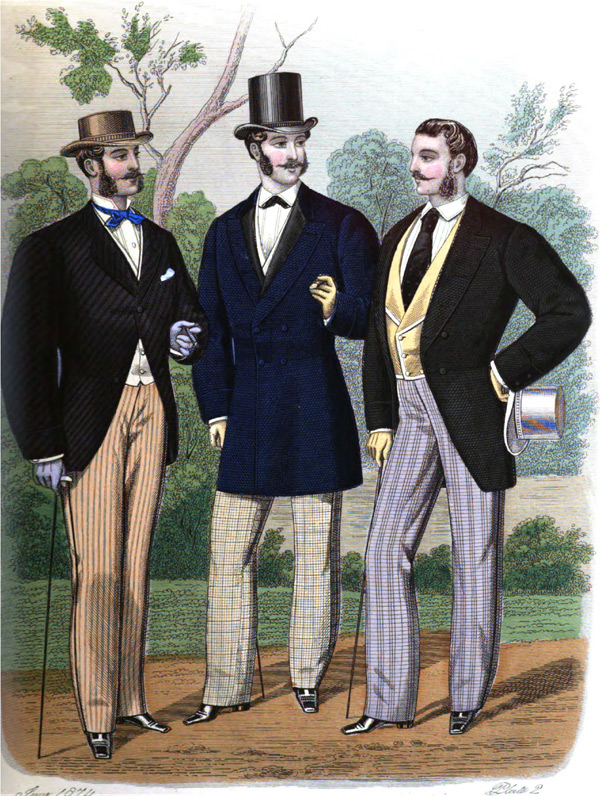Prices and Availability Subject to Change. Please call 800-997-4311 for more Information.
1830s Men's Clothing Guide
We can think of the 1830s as the end of the Georgian period and the beginning of the Victorian, but in fact 1830-1837 was the reign of King William, George IV's brother, 65 years old when he ascended the throne. King William was not nearly so interested in fashion and court life as his brother has been, but nonetheless, London remained the center of men's style, and the flashy dressing a few notable dandies - Count D'Orsay, writers Benjamin Disraeli and Edward Bulwer-Lytton - had a large effect on what gentlemen were wearing in Britain, Europe and America.
Fashions of the 1830s continued in the same theatrical and exaggerated vein as the previous decade. In sharp contrast to the restraint of Beau Brummel and the dandies of the Regency era, the flashy new fashions exemplified the ideals of Romanticism and the appreciation of beauty, personal expression and historical inspiration. A slim waist was considered most elegant, and many well-dressed men donned a corset to create the correct line. Padded chests and shoulders puffed out above and coat tails flared out below.
A change came about with the ascension of Queen Victoria in 1837; her demure personal style caused an abrupt change in the silhouette of womenswear and in menswear. Waistlines straightened and puff sleeves deflated to fit smoothly into armholes once again. This trend in menswear would accelerate in the 1840s upon her marriage in February of 1840 to Albert of Saxe-Coburg and Gotha, who preferred more staid garments.
The decade ended with the introduction of a new technology - daguerreotype. The era of photography had begun. Even though it took from three to fifteen minutes to take a daguerreotype, people still sat for portraits in their best dress or in occupational images that give us a glimpse into how non upper class citizens dressed.
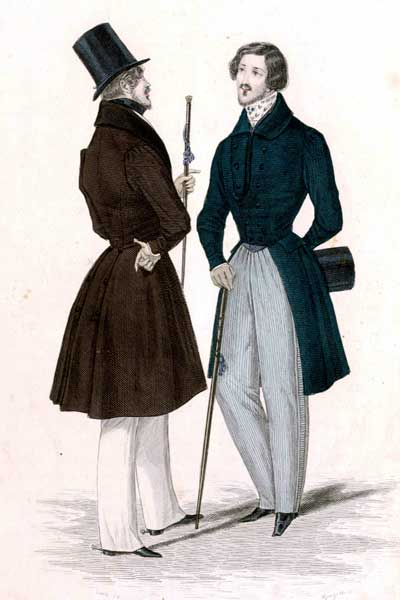

Coats
During the 1830s, gentlemen primarily chose between two coat styles: the tailcoat and the riding coat, also known as the Newmarket. The tailcoat served for formal daytime dress and for evening wear, distinguished by a waist seam that highlighted the era's fashionable silhouette. Its tails could either be square or form a graceful "swallow-tail" shape. The riding coat/Newmarket was a more casual alternative, with a gently sloping front rather than a cutout. Useful for riding and morning strolls, it came to be called the "morning coat."
The frock coat was now frequently worn. Its fitted waist and full, flared skirts to the knee embodied the romantic silhouette of this decade and was a popular choice for informal day wear among fashionable young men.
Collars on all types of coats shortened through the 1830s, and became much more rounded, with a lower neckline frequently worn unbuttoned - and even designed so as not to button up - to showcase the flamboyant waistcoat underneath.
Coats were generally made of fine wool in more somber, dark blues, reds, greens, browns and black. However, linings could be more lively; Disraeli is described as attending an event "dressed with his usual exuberance of lace shirt, flowered waistcoat, and coat with a pink lining."" Velvet was frequently used for collars and facings.
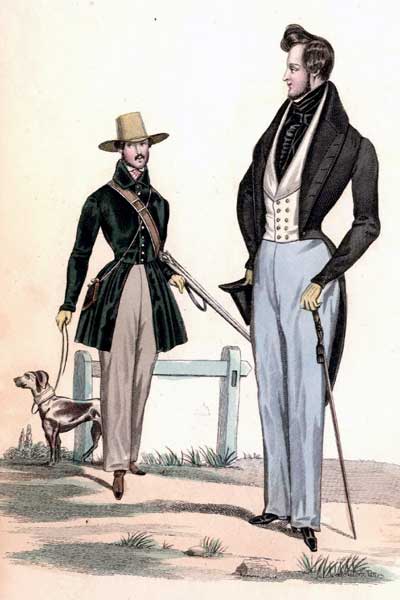
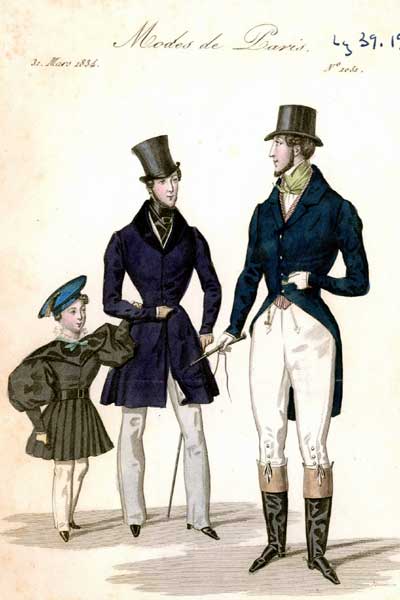

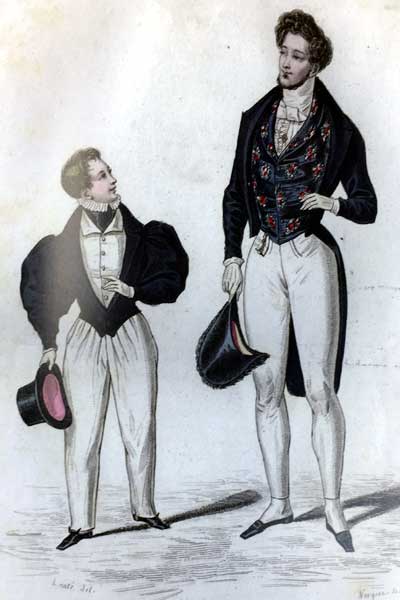
Vests
The vest was the one garment where the 1830s gentleman could really express himself through color, pattern and texture - for the daytime and the evening both, although evening wear was always a little more subdued and white or cream a safe choice. By day vivid hues of velvet, shot silk and cashmere were seen, and the coat was worn fully open to display them to the fullest. Now predominantly featuring a low, shawl collar, single- or double-breasted, with the hem sloping to a point at the center front, these waistcoats were cut lower than previously to best display the pleated or frilled shirt front and elaborately tied cravat or stock. Like the coat, waistcoats were padded and darted to create the ideal Romantic masculine form, round at the chest and fitted at the waist, and it was still common to wear two waistcoats of different colors at once.
In the 1830s, vests (or waistcoats) were where a gentleman could truly express himself in color, pattern, and texture. While evening versions tended to be more subdued, limited to white or cream, daytime vests were made in bold hues of velvet, shot silk, and cashmere. These vests often featured a low shawl collar in single- or double-breasted styles, cut lower than before to show off a pleated or frilled shirt front and an intricately tied cravat or stock. But. to better display this low cut vest, coats then had to be left fully open. Like coats of the period, waistcoats were padded and darted to achieve the Romantic ideal of a rounded chest and narrow waist. It was also not uncommon to wear two waistcoats of different colors at once.
Shirts
Shirts worn under vest and coat still had very tall collars to accommodate the fashionable cravats and stocks. Made from cotton or linen, light colored solid, or even striped, with decoration down the front opening; tucks and pleats for daytime, frills and ruffles for evening wear.

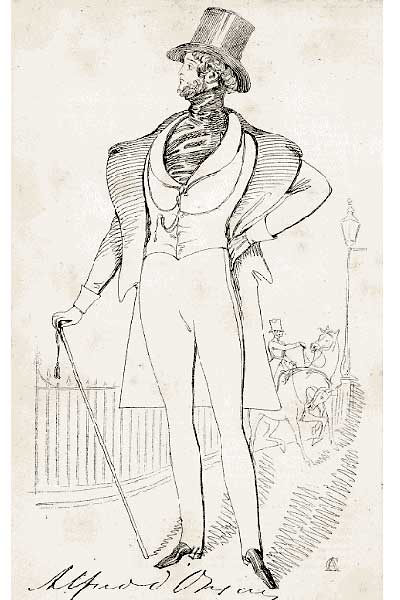
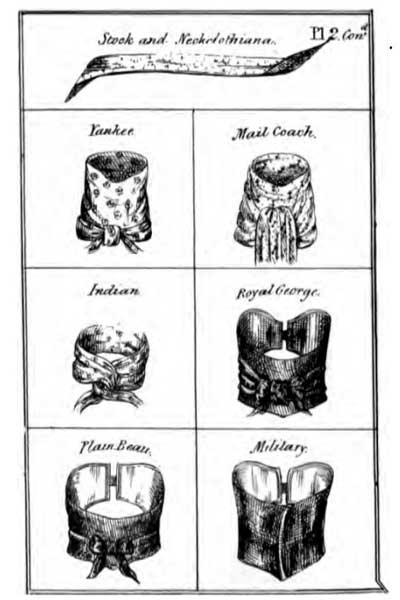
Ties
Neckwear continued to be very important in gentlemen's fashion through the 1830s, and there were many different options available. Stocks, originating in military costume, had been made popular by king George IV in the 1820s and were worn by all the king's entourage, made acceptable by him as 'full dress' and evening wear. A shaped band of horsehair, buckram or whalebone bound with leather, and fastened at the back with ties or a buckle, they were covered in fabric, usually with a bow tied on top. Plain black velvet and silk stocks were the most common and they came in various different heights and shapes.
The cravat, a large square of starched linen, muslin, or silk was still very much in fashion and now worn in a variety of colors. They could be folded into a multitude of styles, with origami-like instructions; the details of which knot was chosen by whom and for what occasion being the subject of many guidebooks. The Count D'Orsay can be seen depicted with a "waterfall" style cravat in black silk, loose and flowing down the shirt-front, fastened with a decorative pin.
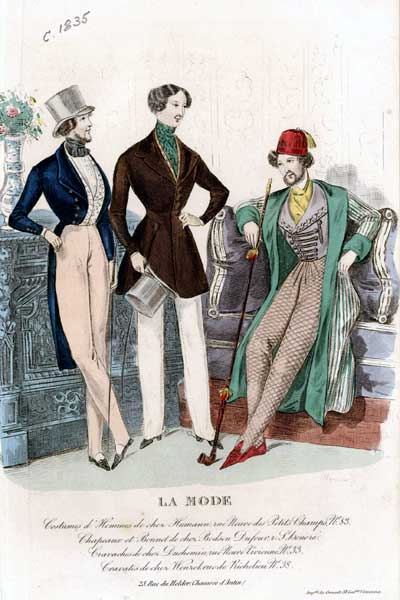
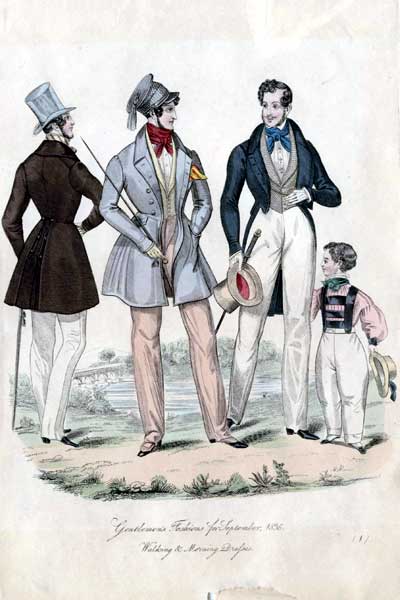
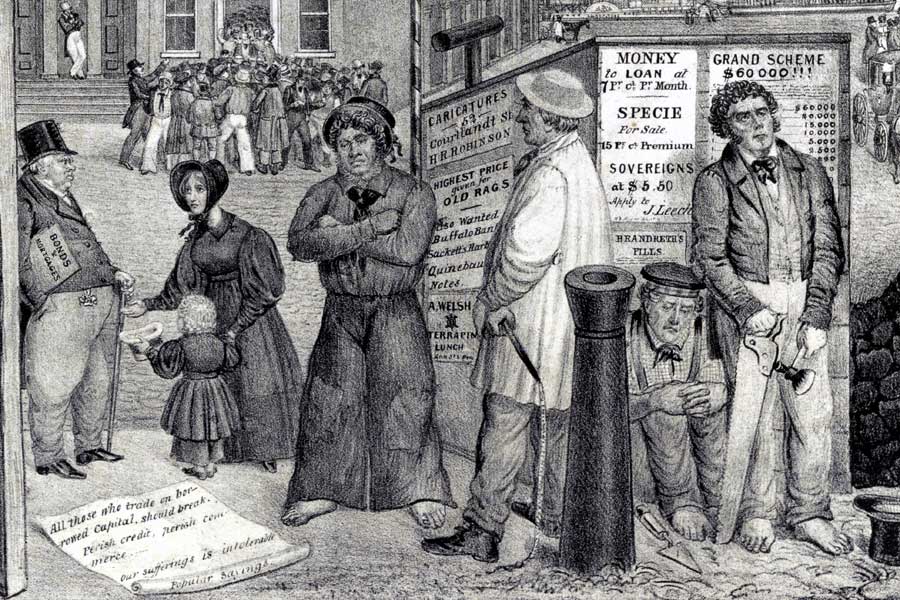
Pants
By the 1830s trousers had generally replaced pantaloons and breeches for all but eveningwear. Trousers could be slim fitting from hip to ankle or full and pleated into the waistband and tapering to the ankle in the "Cossack" style. Both forms were generally constructed with button tabs at the hem to allow for a strap under the shoe, to hold the pants taut for a more elegant appearance. They were made in cotton twill, corduroy, or a yellowish cotton cloth called nankeen. Light colors were favored, although pants could also be striped or checked.
Pant construction was changing with the fall front style giving way to the single button fly, which would be in standard use by 1840. Pants were always worn with suspenders, crossed at the back, belts not becoming commonplace until the 20th century.
Breeches were worn for riding still, often made from a light colored buckskin.
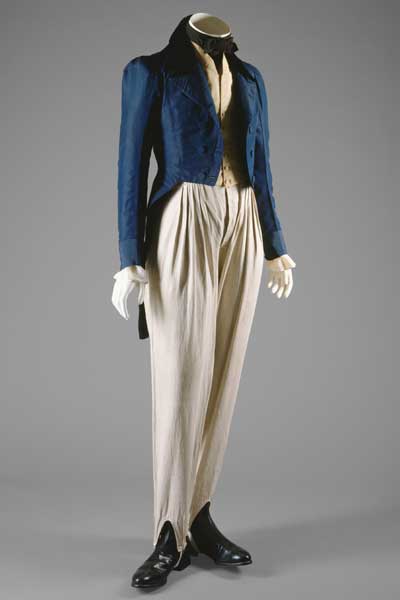
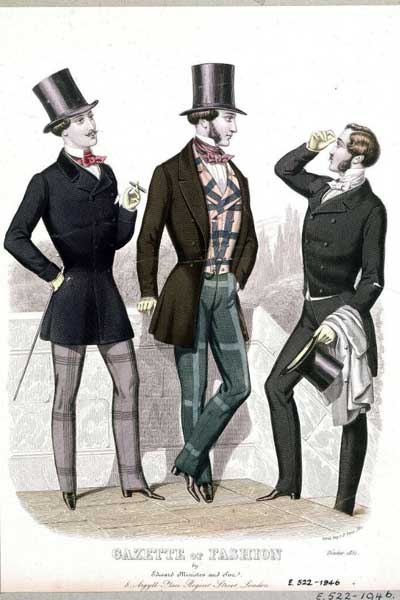
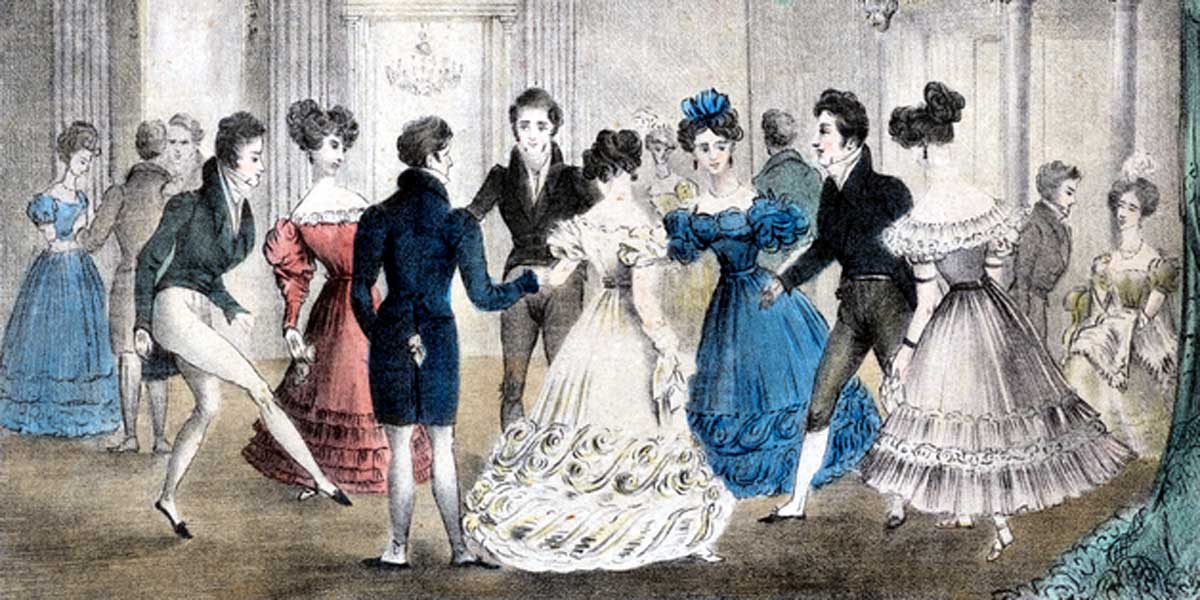
Evening Wear
Evening wear of this period consisted of a dark-colored tailcoat, worn over a dark or cream waistcoat and white shirt with a frilled front. A black silk stock or cravat was a standard choice. However, there was still room for some color and pattern in waistcoats and neckwear through the 1830s. Black, white or cream cashmere pantaloons were worn with silk stocking and black leather dress pumps.
Hats
The top hat was the most commonly worn style for day and evening. Previously made from beaver pelt, manufacturing advances meant that good quality silk top hats were being made for nearly half the price, and they had the advantage of retaining their luster for longer than pelt. There were still multiple shapes to choose from, and a variety of colors, although black was now most commonly seen, along with brown and white for summer. The "Gibus" collapsible top hat was patented in 1835 for folding flat to store while at the opera; it would become very popular later in the century.
Chapeau bras, a flat bicorne hat popular in the Regency era, can still be seen in fashion plates for evening wear of the 1830s.
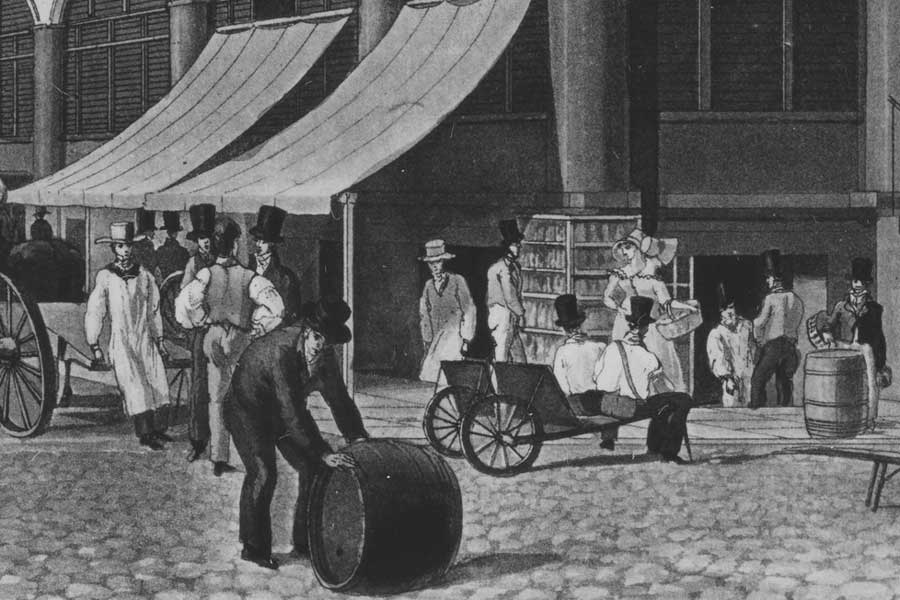
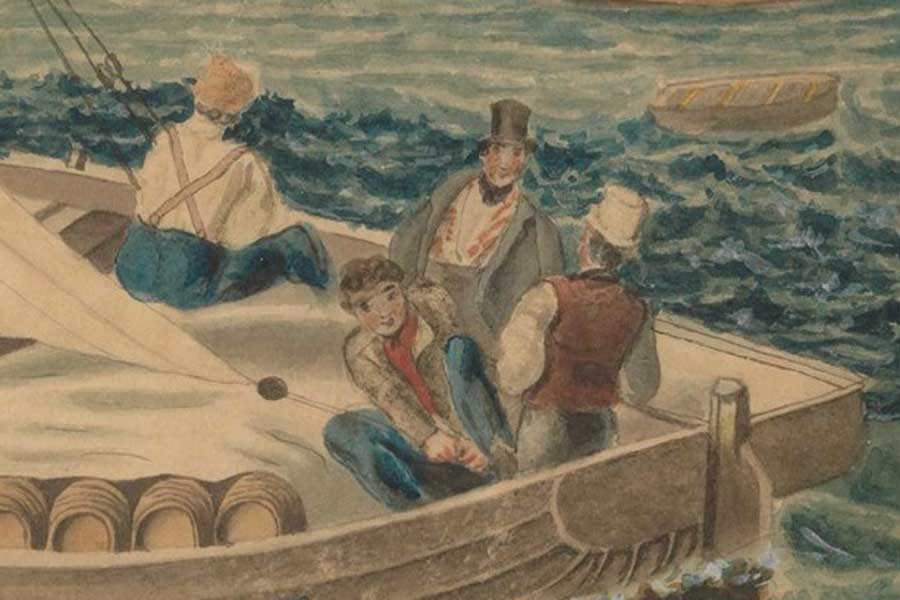
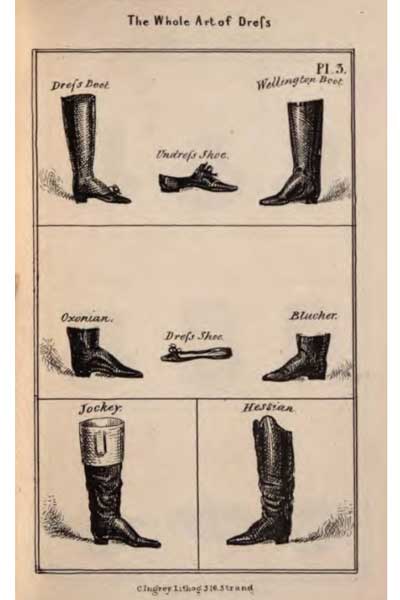
Footwear
Knee-length boots such as the Hessian or Wellington were still worn for riding, but generally shorter boots were worn with trousers for daywear, or even dinner dress. Toe boxes were square, whether in boots or in black leather pumps worn for evening; these were fastened with a wide ribbon tied into a small bow.
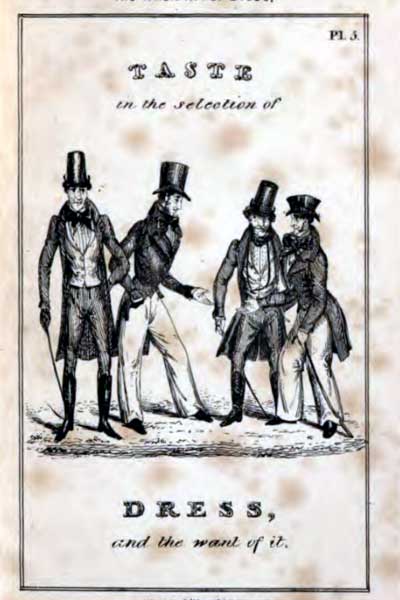
Hair & Accessories
Natural hair was worn longer than previously, with glossy curls highly prized. Men were most often clean shaven, with short sideburns at most. A gentleman would also wear a watch, tucked into the left pocket of the waistcoat.
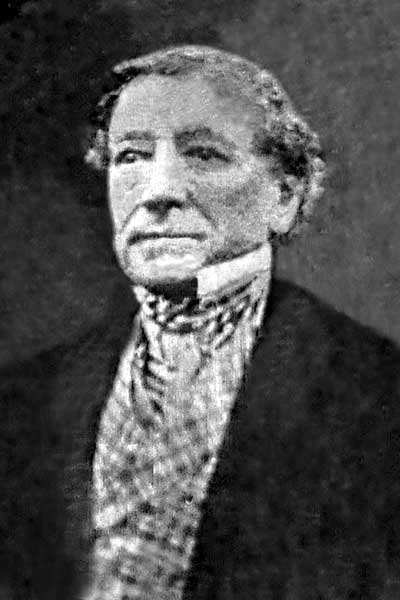
Q&A About 1830s Men's Fashion
What did men wear in the 1830s?
What did upper class men wear in the 1830s?
What did lower class men wear in the 1830s?

Complete Regency Outfits
We offer a full line of men's period clothing which are suitable for movie and TV production, theatrical, living history and performing arts requirements, and are also perfect for vintage weddings!
All of the products we sell are sold individually, but we have put together these full outfits to showcase the elements of Regency style for your consideration and inspiration.
Click any image for a close-up and a list of the products shown.



